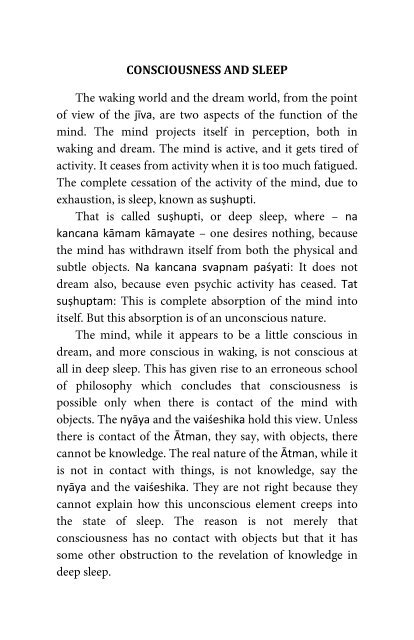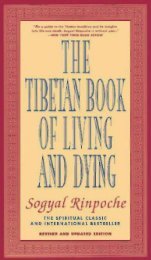CONSCIOUSNESS AND SLEEPThe waking world and the dream world, from the pointof view of the jīva, are two aspects of the function of themind. The mind projects itself in perception, both inwaking and dream. The mind is active, and it gets tired ofactivity. It ceases from activity when it is too much fatigued.The complete cessation of the activity of the mind, due toexhaustion, is sleep, known as suṣhupti.That is called suṣhupti, or deep sleep, where – nakancana kāmam kāmayate – one desires nothing, becausethe mind has withdrawn itself from both the physical andsubtle objects. Na kancana svapnam paśyati: It does notdream also, because even psychic activity has ceased. Tatsuṣhuptam: This is complete absorption of the mind intoitself. But this absorption is of an unconscious nature.The mind, while it appears to be a little conscious indream, and more conscious in waking, is not conscious atall in deep sleep. This has given rise to an erroneous schoolof philosophy which concludes that consciousness ispossible only when there is contact of the mind withobjects. The nyāya and the vaiśeshika hold this view. Unlessthere is contact of the Ātman, they say, with objects, therecannot be knowledge. The real nature of the Ātman, while itis not in contact with things, is not knowledge, say thenyāya and the vaiśeshika. They are not right because theycannot explain how this unconscious element creeps intothe state of sleep. The reason is not merely thatconsciousness has no contact with objects but that it hassome other obstruction to the revelation of knowledge indeep sleep.
The third foot of the Ātman the third phase of itsanalysis, is deep sleep, where all perceptions and cognitionsconverge into a single mode of the mind – ekībhūtah. Itbecomes a mass of consciousness, which is not projectedoutside – prājñana-ghanah. There is no modification of themind, and so there is no external consciousness. We are notaware of the world outside in the state of sleep because ofthe absence of vṛittis, or psychoses, of the mind. Only whenthe mind becomes extrovert can it have consciousness ofthe outer world, whether in dream or in waking. But, thereis no agitation of the mind, of that nature, in sleep. It is as ifthere is a homogeneous mass of all perceptions, where allthe samskāras, vāsanas, commingle into a single mode, orcondition, instead of there being many cognitive psychoses.Ānandamayo ānandabhuk cetomukhah prājñah: It is allbliss. The happiness of deep sleep is greater than all otherforms of happiness or pleasure born of sense-contact. It isfilled with ānanda, bliss, delight, satisfaction. Even a kingcannot be happy if he does not have sleep for a week. Allthe worlds may be given to you, but if you will not beallowed to sleep, you would rather say, “Let me sleep. I donot want any world. You take your kingdom back, all yourempire. You allow me to sleep peacefully.” An empirecannot give you that happiness, the power which you mayseem to have over the world cannot give you thatsatisfaction, which you have while you are alone in deepsleep, unbefriended, unprotected, unseen, uncognised,unpossessed of anything. While you are possessed of somany things in the world, with all the retinue of a kingdom,with the power that you wield in society, you have a87
- Page 1 and 2:
THE MĀNDŪKYAUPANISHADSWAMI KRISHN
- Page 3 and 4:
CONTENTSPublishers’ Preface ...
- Page 5 and 6:
INTRODUCTIONThe theme of the Manduk
- Page 7 and 8:
ceases to agitate the mind any more
- Page 9 and 10:
INVOCATION AND VERSESOm! Bhadram ka
- Page 11 and 12:
svapna-sthāno’ntaḥ-prajñaḥ
- Page 13 and 14:
8. This identical Ātman, or Self,
- Page 15 and 16:
THE PRANAVA OR OMKARAThe Vedas, in
- Page 17 and 18:
and rūpa, name as well as form. It
- Page 19 and 20:
Now, we come from what we call Īsv
- Page 21 and 22:
and to achieve this by a direct met
- Page 23 and 24:
structure and the glory of Om. With
- Page 25 and 26:
desire persisting, it would only po
- Page 27 and 28:
magnificence of Om, but how are we
- Page 29 and 30:
experience a thrill, as if an elect
- Page 31 and 32:
THE INDIVIDUAL AND THE ABSOLUTEThe
- Page 33 and 34:
vai tat. The reconciliation of “t
- Page 35 and 36: yaccānyat trikālātitam tadapyomk
- Page 37 and 38: The ultimate longing of all aspirin
- Page 39 and 40: to the realisation of asti-bhāti-p
- Page 41 and 42: structural difference is an effect
- Page 43 and 44: self is the false self, not the rea
- Page 45 and 46: cow, with four feet? The four feet
- Page 47 and 48: Consciousness. A study of conscious
- Page 49 and 50: THE UNIVERSAL VAIŚVĀNARAThis Ātm
- Page 51 and 52: these dealings are with ‘other’
- Page 53 and 54: the Virāt, or the Universal Person
- Page 55 and 56: logical discrimination. This is the
- Page 57 and 58: it were. This is the function of th
- Page 59 and 60: world’s existence, not merely a p
- Page 61 and 62: subtle body is not visible to us, a
- Page 63 and 64: Now, we consider the meaning of bah
- Page 65 and 66: ecause the consciousness of the jī
- Page 67 and 68: cannot have power over things. We a
- Page 69 and 70: we have about the dream world in re
- Page 71 and 72: is a complicated case for investiga
- Page 73 and 74: never pass such a judgment. You are
- Page 75 and 76: are in a particular state, that sta
- Page 77 and 78: But, if you feel that by waking up
- Page 79 and 80: The dream consciousness which is ta
- Page 81 and 82: ecause freewill is only as much rea
- Page 83 and 84: Dreams, therefore, are due to repre
- Page 85: egarded as pravivikta, sūkṣhma,
- Page 89 and 90: ānanda, swallow ānanda, consume
- Page 91 and 92: Causal Condition, known as Īsvara.
- Page 93 and 94: ocean is being described here, the
- Page 95 and 96: of an effect, namely, the plant, an
- Page 97 and 98: Īsvara’s Being. For Him, it is a
- Page 99 and 100: or Destroyer, more than a cause of
- Page 101 and 102: which you have seen, heard, etc.? B
- Page 103 and 104: where existence becomes identical w
- Page 105 and 106: simply are. You have become That, a
- Page 107 and 108: peaceful. But the peace of the Ātm
- Page 109 and 110: seen the Ātman? Can you get the Ā
- Page 111 and 112: THE ĀTMAN AS THE PRANAVAThe Ātman
- Page 113 and 114: the Ātman in the waking state is c
- Page 115 and 116: symbolic, as the comparison of Brah
- Page 117 and 118: Therefore, your generation, your po
- Page 119 and 120: the deep sleep state, even as all o
- Page 121 and 122: elationless. Samviśatyatmanātmān



